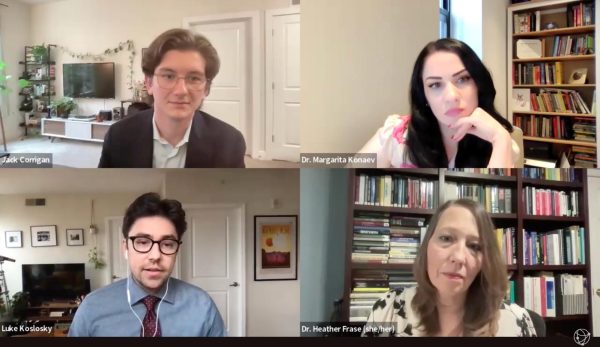Georgetown University’s Center for Security and Emerging Technology (CSET) hosted a virtual panel discussion Jan. 31 to review implementation of the Biden administration’s artificial intelligence (AI) executive order.
The event, titled “AI Executive Order Report Card,” was part of CSET’s ongoing Security and Emerging Technology Seminar Series, which discusses the security impacts of artificial intelligence and emerging technologies. Panelists included Jack Corrigan, a senior research analyst specializing in national innovation and competitiveness; Heather Frase, a senior fellow working on AI assessment; and Luke Koslosky, a research analyst specializing in workplace policy. All three are currently engaged in research at CSET.
Margarita Konaev, research fellow and deputy director of analysis at CSET, moderated the discussion.
The Biden administration issued an executive order calling for U.S. government agencies to meet new standards for AI Oct. 30, 2023. It aims to address a range of AI-relevant issues, prioritizing security and technological innovation.
Koslosky said people can learn how to understand AI, which refers to the simulation of human intelligence in machines, even if they do not know anything about computer science.
“Just being able to understand how AI works — the different components you need, the risks, the different types of biases, its impact — those can all be learned without needing to know a line of code,” Koslosky said.
The panel discussed specific provisions within the executive order, in addition to the U.S. government’s progress in implementing the order over the last 90 days since its issuance.
Corrigan said provisions around AI governance in critical infrastructure particularly stood out to him.

“The EO very clearly laid out a timeline for assessing AI risk in critical infrastructure. It tasked agencies that are responsible for regulating different critical infrastructure sectors using the NIST Risk Management Framework and, kind of, including that into existing security and safety guidelines,” Corrigan said. “And then, it really did lay out a process for turning those guidelines into binding regulations where it’s required.”
The National Institute of Standards and Technology (NIST) Risk Management Framework provides a structured approach for organizations to secure their information systems. NIST also released its AI Risk Management Framework on Jan. 26, 2023, which guides organizations on how to incorporate trustworthiness into their AI use.
Frase said the majority of the executive order, however, lacks such explicit frameworks toward regulation.
“A lot of the directives are actually telling people to make plans or to develop guidance. That’s an important step,” Frase said at the event. “But that doesn’t mean that a lot of these safety measures — a lot of these processes — to ensure responsible AI systems will be actually implemented. That’s another further step, and the big thing that we require for that is funding.”
“This is one of the limitations of an EO. It doesn’t mean the EO was deficient. It just means this is what an EO can do, and it did what it can do. But it is not alone going to solve our problems,” Frase added.
Koslosky said the executive order also fails to adequately define AI talent, both technical and non-technical.
“Within the EO, they don’t really define it well, and across the standard government, different government organizations and agencies have disparate lists of AI competencies and AI roles. But it isn’t really standardized, especially for non-technical talent,” Koslosky said. “So the EO does mention AI-enabling talent, and as they ramp up their recruitment and hiring efforts, they have to make sure that the non-technical occupations and roles that make up this so-called AI-enabling talent are actually defined and emphasized.”
Despite the limitations of President Biden’s AI executive order, the three panelists agreed that it was on the right track for implementation. According to Koslosky, none of the order’s provisions are overdue, though some are still in progress.
“Of those 38 provisions and required tasks I talked about earlier, 11 have already been completed. Two related to immigration are a little difficult for me to judge from the outside without talking to embassies overseas. 25 are still in progress, but they aren’t due yet,” Koslosky said.
The panelists then answered questions from attendees about the executive order, as well as its implications for AI in the public and private sectors.
Corrigan said this executive order demonstrates how the government has ceded control of technology development to the private sector, although it is now compensating with a targeted policy approach.
“Since about the early ’80s, we’ve seen the private sector outspending the government on R&D like 4:1. I think, in AI, the gap is even bigger,” Corrigan said at the event.
“I don’t see the EO as the government trying to reassert its control over AI innovation,” Corrigan added. “I don’t think that the White House wants to change that. I personally don’t think that agencies should be the ones that are really driving it at a high level, but I do think the EO shows that the government is interested in steering that trajectory through other policy levers like competition, enforcement, regulation, standard setting — that kind of thing.”









